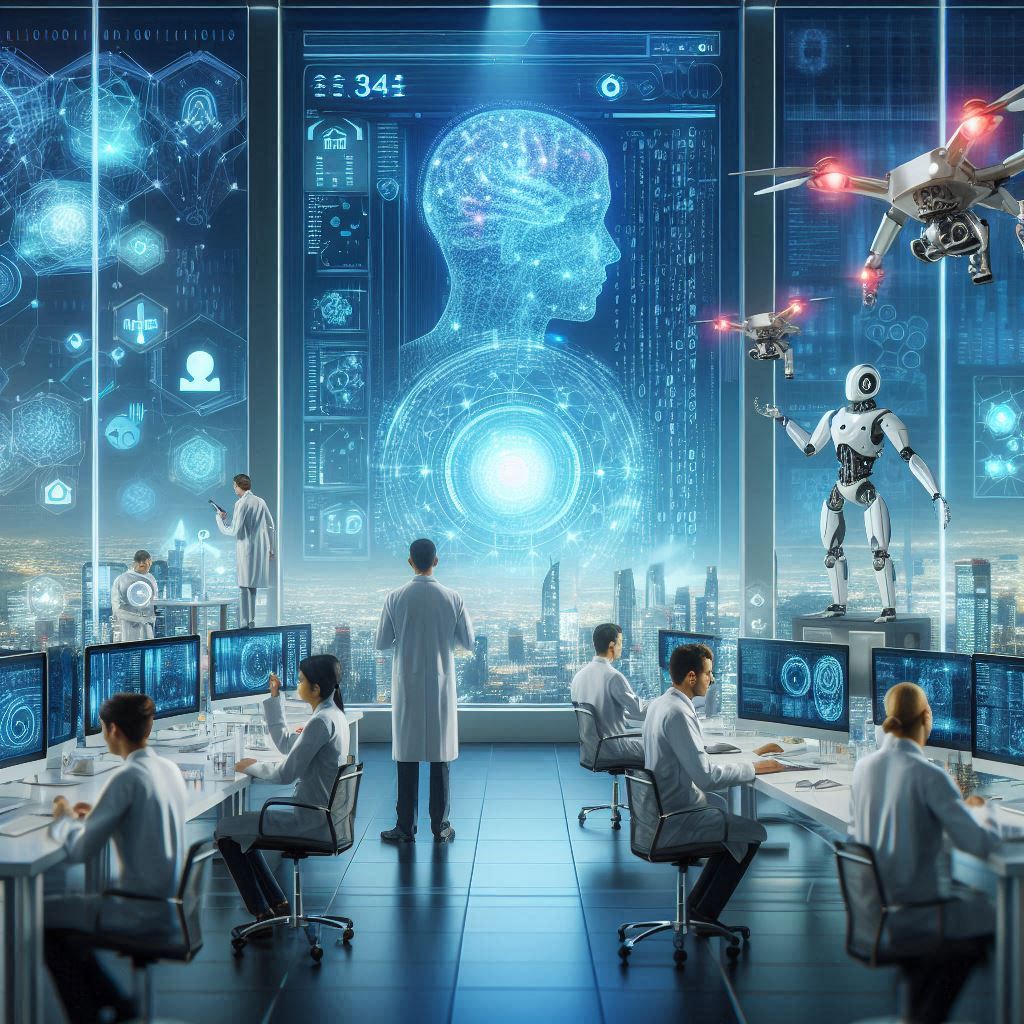Artificial Intelligence (AI) has become a transformative force across various industries, driving innovation and efficiency in ways previously thought impossible. From healthcare to finance, entertainment to transportation, AI’s influence is pervasive and profound. As we stand on the cusp of further groundbreaking advancements, staying updated with the latest developments in AI technology is crucial. This article aims to provide an overview of the most recent advancements in AI, highlighting how these innovations are shaping the future and impacting our daily lives.
Natural Language Processing (NLP)
Natural Language Processing (NLP) has seen significant strides in recent years, particularly with the development of advanced language models like GPT-4 and GPT-4 Turbo. These models have dramatically improved the ability of machines to understand and generate human language, making interactions with AI more natural and intuitive. For instance, the enhanced capabilities of these models are evident in more accurate machine translation, which now supports a broader array of languages with higher fidelity. This has far-reaching implications for global communication, breaking down language barriers and enabling seamless interaction across different cultures.
Additionally, advancements in sentiment analysis allow businesses to gain deeper insights into customer opinions and feedback, enabling more tailored and effective strategies. These tools can analyze vast amounts of social media data, customer reviews, and other text sources to gauge public sentiment and predict market trends. Text summarization tools have also become more sophisticated, providing concise and relevant summaries of large documents, which is particularly useful in fields like law and academia where quick and accurate information retrieval is essential.
Computer Vision
Computer vision technology has made remarkable progress, particularly in the areas of image and video recognition. These advancements are driving innovations in various sectors, such as healthcare, where AI-powered medical imaging systems can now detect anomalies with greater accuracy, aiding in early diagnosis and treatment planning. For example, AI algorithms can analyze X-rays, MRIs, and CT scans to identify early signs of diseases like cancer, potentially saving lives through timely intervention.
In the automotive industry, computer vision is a cornerstone of autonomous vehicle technology, enabling self-driving cars to navigate complex environments safely. This involves real-time analysis of the surroundings, recognizing objects, pedestrians, and other vehicles, and making split-second decisions to avoid collisions. Moreover, advancements in surveillance systems leverage computer vision to enhance security and monitoring, using real-time video analysis to detect unusual activities or threats, thus improving public safety and crime prevention.
Reinforcement Learning
Reinforcement learning (RL) has seen groundbreaking achievements, particularly in the realm of game-playing AI. Models like AlphaZero and MuZero have demonstrated the potential of RL by mastering complex games such as chess, Go, and Atari games without prior knowledge of the rules, learning purely through self-play. These models learn by trial and error, receiving rewards for successful actions and penalties for mistakes, gradually improving their performance through repeated practice.
Beyond games, RL is being applied in industrial automation, where robots learn to optimize production processes, improving efficiency and reducing costs. For instance, RL algorithms can be used to manage supply chains, allocate resources, and streamline manufacturing workflows. In the field of logistics, RL algorithms enhance decision-making processes, such as optimizing delivery routes and managing inventory, thus streamlining operations and reducing operational costs.
AI in Healthcare
AI’s integration into healthcare has ushered in a new era of diagnostics and personalized medicine. Advanced AI algorithms can now analyze vast amounts of medical data, identifying patterns that human eyes might miss, leading to more accurate diagnoses. For example, AI-driven systems are being used to detect cancers at early stages, significantly improving patient outcomes. Additionally, AI can predict patient outcomes based on historical data, enabling personalized treatment plans tailored to individual patients.
Innovations in drug discovery are another area where AI is making a substantial impact. Machine learning models can predict the efficacy of new compounds, accelerating the development of new medications. By analyzing large datasets of chemical properties and biological effects, AI can identify promising drug candidates more quickly and at a lower cost. Furthermore, AI is playing a crucial role in managing and predicting pandemics by analyzing data to track the spread of diseases and optimize response strategies. AI-driven models can predict outbreak patterns, identify high-risk areas, and suggest effective containment measures, thus helping to mitigate the impact of global health crises.
Ethical AI and Bias Mitigation
As AI systems become more pervasive, addressing ethical concerns and mitigating biases has become paramount. Researchers are developing frameworks for ethical AI to ensure that these technologies are used responsibly. These frameworks include guidelines for transparency, accountability, and fairness in AI development and deployment. Techniques for identifying and reducing biases in AI systems are also advancing, helping to create fairer and more equitable AI applications. This involves analyzing training data for biases, developing algorithms that minimize bias, and continuously monitoring AI systems for unintended discriminatory behavior.
Initiatives promoting transparency and accountability in AI development are gaining traction. These efforts include creating open-source tools and datasets, encouraging collaboration between researchers and industry, and developing policies that govern the ethical use of AI. For example, many organizations are adopting explainable AI (XAI) techniques that provide insights into how AI systems make decisions, helping users understand and trust these systems. Additionally, regulatory bodies are beginning to establish standards and guidelines for AI ethics, ensuring that AI technologies are developed and used in ways that benefit society as a whole.
AI and Quantum Computing
The intersection of AI and quantum computing is a burgeoning field with the potential to revolutionize problem-solving and optimization. Quantum computers, with their ability to process information at unprecedented speeds, can enhance AI algorithms, making them more powerful and efficient. Early applications and experimental results indicate significant potential in areas such as cryptography, material science, and complex system simulations. For instance, quantum AI could revolutionize fields like drug discovery by simulating molecular interactions with unparalleled accuracy, leading to the development of new medications and treatments.
Quantum computing’s ability to handle vast amounts of data simultaneously also promises to improve machine learning models, enabling faster training and more accurate predictions. As quantum hardware continues to advance, the integration of AI and quantum computing is expected to unlock new possibilities in data analysis, optimization, and simulation, pushing the boundaries of what is currently achievable with classical computing.
AI in Edge Computing
AI’s integration with edge computing is transforming how data is processed and analyzed. By bringing computation closer to the data source, edge AI reduces latency, enhances privacy, and enables real-time decision-making. This is particularly beneficial in applications like smart homes, where AI-driven IoT devices can respond instantaneously to user commands, creating more responsive and intuitive environments.
In industrial settings, edge AI allows for real-time monitoring and predictive maintenance of machinery, improving operational efficiency. For example, AI algorithms can analyze sensor data from manufacturing equipment to detect signs of wear and tear, predicting failures before they occur and scheduling maintenance to avoid costly downtime. The combination of AI and edge computing is also driving advancements in autonomous systems, such as drones and robotic assistants, which require fast and reliable processing capabilities to navigate and interact with their environments effectively.
AI for Sustainability
AI is playing a crucial role in addressing global sustainability challenges. Advanced AI models are being used to predict and mitigate the impacts of climate change, analyzing vast datasets to identify trends and develop actionable insights. For example, AI can model weather patterns, predict extreme weather events, and suggest mitigation strategies to protect vulnerable communities. In energy management, AI optimizes the use of renewable resources and enhances grid efficiency, contributing to a more sustainable energy ecosystem. By analyzing data from renewable energy sources like wind and solar, AI can predict energy production, balance supply and demand, and reduce reliance on fossil fuels.
Sustainable agriculture is another area benefiting from AI, with technologies that monitor crop health, optimize irrigation, and manage pests more effectively. For instance, AI-driven systems can analyze satellite imagery and sensor data to detect crop diseases early, allowing farmers to take timely action and minimize losses. These innovations are
helping to reduce resource consumption and increase agricultural productivity, supporting global food security. Furthermore, AI is being employed in conservation efforts, using data analysis to protect endangered species and manage natural resources more sustainably.
AI in Creative Fields
AI’s influence extends to creative fields, where it is being used to generate art, music, and literature. AI-generated art is gaining recognition, with algorithms capable of producing unique and visually stunning pieces. Artists are leveraging AI tools to explore new styles and techniques, pushing the boundaries of traditional art forms. For example, AI can analyze vast collections of artwork, learning patterns and styles to create original compositions that blend different artistic influences.
In music, AI tools assist in composing and arranging tracks, offering new possibilities for artists and producers. AI algorithms can generate melodies, harmonize compositions, and even mimic the style of famous musicians, providing a rich source of inspiration. Additionally, AI-powered music platforms are enhancing the listening experience by personalizing playlists and recommending new music based on individual preferences.
Enhanced virtual and augmented reality experiences are being developed with the help of AI, creating immersive environments for entertainment, education, and training. AI algorithms can generate realistic 3D models, animate characters, and create interactive narratives, providing users with engaging and dynamic experiences. In education, AI-driven virtual tutors can adapt to students’ learning styles, offering personalized guidance and support.
Collaborative tools powered by AI are also supporting creators by automating repetitive tasks and providing new insights, allowing them to focus more on the creative process. For example, AI can assist writers by suggesting plot developments, character interactions, and stylistic improvements, enhancing the storytelling process.
Future Trends and Predictions
Looking ahead, we can expect significant advancements in AI hardware and software. Innovations in AI chip design are likely to improve processing speeds and energy efficiency, enabling more powerful AI applications. For instance, neuromorphic computing, which mimics the architecture of the human brain, promises to revolutionize AI by providing more efficient and scalable hardware solutions.
The development of more sophisticated algorithms and models will continue to push the boundaries of what AI can achieve. Advances in transfer learning, for example, will allow AI systems to apply knowledge gained from one task to new, related tasks, improving their versatility and efficiency. Additionally, the integration of AI with other emerging technologies, such as blockchain and the Internet of Things (IoT), will create new opportunities for innovation and collaboration.
However, the rapid advancement of AI also presents challenges. Ensuring the ethical use of AI, addressing privacy concerns, and managing the societal impact of automation are critical issues that need to be addressed. As AI systems become more integrated into our daily lives, it is essential to establish robust ethical guidelines and regulatory frameworks to protect individuals and society as a whole.
Despite these challenges, the potential benefits of AI are immense, and its continued evolution promises to bring about transformative changes across various sectors. By fostering collaboration between researchers, industry, and policymakers, we can harness the power of AI to drive positive change and create a more prosperous and equitable future.
Conclusion
In conclusion, the latest advancements in AI technology are driving innovation and efficiency across numerous fields. From improved natural language processing and computer vision to breakthroughs in reinforcement learning and healthcare, AI is reshaping our world in profound ways. As we move forward, it is essential to stay informed and engaged with these developments, embracing the opportunities they present while addressing the challenges they pose.
By understanding and leveraging the power of AI, we can unlock new possibilities for innovation, improve our quality of life, and address some of the most pressing challenges facing our world today. As AI continues to evolve, it is crucial to approach its development and deployment with a sense of responsibility and a commitment to ethical principles, ensuring that the benefits of AI are shared by all.
References and Further Reading
To delve deeper into the topics discussed in this article, consider exploring the following resources:
- Key research papers on AI advancements, such as those published in journals like Nature Machine Intelligence and Journal of Artificial Intelligence Research.
- Books like “Artificial Intelligence: A Modern Approach” by Stuart Russell and Peter Norvig, and “Superintelligence: Paths, Dangers, Strategies” by Nick Bostrom.
- Online courses and learning platforms such as Coursera, edX, and Udacity, which offer comprehensive AI programs and specializations.
- Websites and online resources, including the AI sections of major tech news sites like Wired, TechCrunch, and MIT Technology Review.
Author’s Note
Reflecting on the journey of understanding AI, it’s evident that the field is evolving rapidly, offering exciting opportunities for innovation and discovery. I encourage readers to delve deeper into AI technologies, share their thoughts and experiences, and participate in shaping the future of AI. The possibilities are endless, and the journey is just beginning.
By staying curious and informed, we can all contribute to the development of AI in ways that enhance our lives and drive positive change in society. Whether you’re a seasoned professional or a newcomer to the field, there are countless ways to engage with AI and explore its potential. Embrace the journey, and let the wonders of AI inspire you to reach new heights in your personal and professional endeavors.


